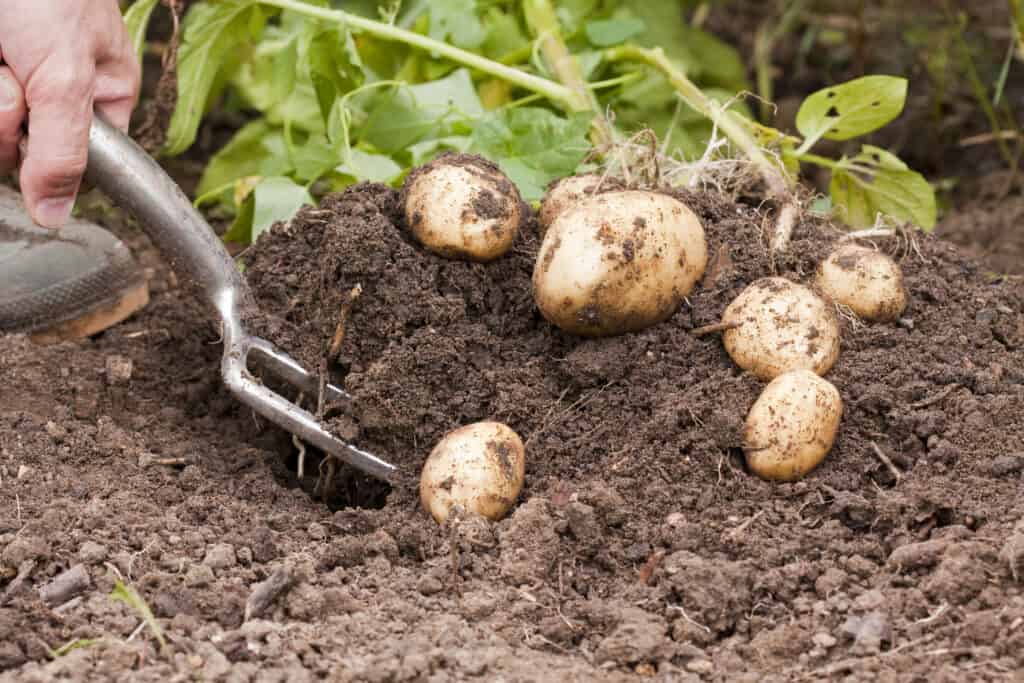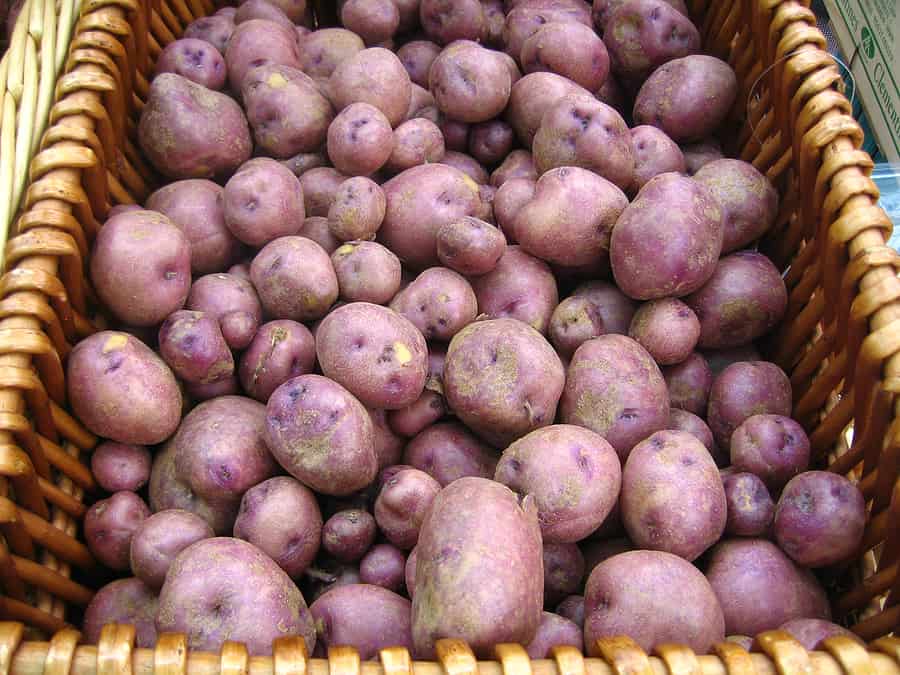Harvest potatoes young or mature.
Mature, full-size potatoes are called maincrop potatoes. Maincrop potatoes are often cured and stored for later use. Maincrop potatoes are ready for harvest when most of the top foliage has withered
Small, round, immature potatoes are often called “new potatoes.” New potatoes are usually eaten skin and all. New or early potatoes can be harvested for table use at any time.
Related articles:

Potato harvest times
The length of a potato’s growing season varies according to climate and variety.
You can choose cultivars for each of the three harvest periods.
- First early potatoes—grow rapidly, take little space, and are harvested early to midsummer when they are about the size of an egg.
- Second early potatoes—are midseason potatoes that grow rapidly, take little space, and are planted a month after the first earlies. Second early potatoes are harvested in late summer to early fall.
- Main crop potatoes—are grown to maturity for both immediate consumption and storage over the winter. They are harvested early to mid-fall.
Tools for Vegetable Gardeners at Amazon:
- A.M. Leonard Straight Rake with Ash Handle
- All-Steel Nursery Spade with D-Grip Handle
- 4-Tine Spading Digging Fork with D-Handle
- Digital Soil pH Meter Outdoors Greenhouse
- Earthwise Handheld Electric Fertilizer Spreader
Usual harvest times by potato variety or type
- Blue potatoes: fall
- Round red potatoes: late summer and early fall
- Fingerlings: fall through spring
- German Butterball: late summer
- Russian Banana: late summer
- Long whites: spring through summer
- New potatoes: late winter or early spring through summer
- Russet: year-round
- Yellow-fleshed: late summer and early fall
When to harvest potatoes
- Harvest large, mature, maincrop potatoes about 15 weeks after planting when the foliage begins to die back.
- Harvest new potatoes when plants begin to flower and for another 2 to 3 weeks, starting about 60 to 70 days after planting.
- It’s best to harvest potatoes on a warm, dry day after a few days of no rain or a cloudy day will do.
- Some potato varieties bloom late or do not bloom. If you do not see flowers 65 to 75 days after planting, check near the base of the plant for developing tubers. Potato tubers form on underground stems called stolons. Potato stolons are typically 12 to 18 inches long; so developing tubers will be within that circumference of the plant.

How to harvest new potatoes
- To harvest new potatoes gently lift the plant with your hands or a garden trowel or hand multi-pronged garden fork. As you lift the plant, the surrounding soil and mulch will fall away.
- Take as many new potatoes as you need then set the plant back in place and firm the soil so that the plant and remaining tubers can grow on. (Do not leave the plant out of the soil for long; the sun can damage exposed roots and tubers.)
- As an alternative, you can lift a whole plant for harvest and leave the neighboring plants undisturbed. The potatoes you leave in the ground will grow to become your main crop—your mature tuber crop and the plant will produce new potatoes as well.
- If the plant is growing in hills of very loose soil, mulch, or straw, you can simply ease your hand into the tuber zone and remove new potatoes.
How to harvest main crop potatoes
- Mature or maincrop potatoes will be ready for harvest 2 to 3 weeks after plants turn yellow and die back—about 100 to 110 days after planting.
- Vines will either die back naturally or, to spur harvest, you can break off the stems at ground level to stop growth.
- Between the time the plant dies back and harvest, do not water potato plants. A dry period will allow skins to “set” or harden which is important for long storage.
- Harvest mature potatoes using a spading fork. Work from the edge of the planting row or bed inwards.
- Insert your fork 10 to 18 inches away from the plant stem. Loosen and turn the soil carefully so the potatoes you lift are not damaged.
- Most of the crop will be on the same level in the top 4 to 6 inches of the soil. If you know how deep the tubers are growing, you can use a garden spade to lift the entire hill.
- If the potato plant does not die back as the tubers mature, cut the plant off at soil level two weeks before you want to harvest the tubers.
- It is easiest to dig potatoes when the soil is dry. If the weather has been rainy, wait a few days until the soil dries to begin your harvest.

Drying and curing potatoes
- Let harvested potatoes sit in the garden for an hour or so to dry. As the tubers and soil dry, the soil will drop away from the tubers. If the soil does not drop away, use a soft brush to remove the soil from the tubers. Do not wash just harvested potatoes; washing potatoes will shorten their storage life.
- Newly harvested potatoes do not have tough skin so handle them carefully to avoid bruising which can lead to rot.
- Set the tubers on a screen or lattice where they can dry for an hour. If you leave them longer, set them in a dark, dry place where it is a bit humid.
- Maincrop potatoes that you want to store should be allowed to “cure” for one to two weeks after harvest. Curing will allow cuts, nicks, and bruises to heal.
- Potatoes with deep cuts or bruises are best used right away and not stored.

How to store potatoes
- New potatoes will be most flavorful if eaten almost immediately after digging.
- Store main crop potatoes in a dark, dry place for a week or two at 55° to 65° F with high humidity of 85 to 85 percent.
- After two weeks, potatoes that you want to store longer for winter use should be moved to a much cooler– 35° to 40°F—dark room, basement, or root cellar with moderate humidity and ventilation.
- For long storage—as long as eight months, choose potatoes that are firm with no soft spots. Temperatures higher than 40°F will cause tubers to sprout and shrivel.
- Check stored potatoes often; if sprouts begin to form, knock the sprouts off with your hands.
- Do not refrigerate potatoes; the air in a refrigerator is too dry for potatoes and can cause them to shrivel. Do not store potatoes with apples; picked apples expel ethylene gas which will cause potatoes to spoil.
Common potato storage problems
- Some potatoes can become “sweet” when stored. Potatoes in storage may convert starch to sugar which is used in the tuber “breathing” process. The breathing process of potatoes stored in a cool place slows so that the starch converted to sugar is not used in full; the unused sugar will give the potatoes a sweet taste when cooked. To avoid a sweet taste, take the potatoes out of storage several days in advance of cooking so that the extra sugar can revert to starch—a process called “reconditioning.”
- The skins of potatoes exposed to light can turn green. Greening is caused by a toxic alkaloid called solanine. Green potatoes taste bitter. Do not eat green potatoes; solanine can cause illness. If a potato skin is green, peel or cut away the green before cooking.
- Be advised that the leaves of potato plants are poisonous to humans and animals.
Kitchen tips: Seven Ways to Cook Potatoes
Growing tips: How to Grow Potatoes
Garden Planning Books at Amazon:
- Vegetable Garden Grower’s Guide
- Tomato Grower’s Answer Book
- Vegetable Garden Almanac & Planner
- Kitchen Garden Grower’s Guide Vegetable Encyclopedia
More harvest tips:
Learn when and how to harvest your favorite vegetables for the best flavor and texture. Get storage tips for each crop. Click on the vegetable you are growing below.
- Artichoke
- Arugula
- Asparagus
- Beans
- Beets
- Broccoli
- Brussels Sprouts
- Cabbage
- Cantaloupe — Melons
- Carrots
- Cauliflower
- Celery
- Chard
- Collards
- Corn, Sweet
- Cucumbers
- Eggplant
- Endive and Escarole
- Garlic
- Jerusalem Artichoke
- Kale
- Kohlrabi
- Leeks
- Lettuce
- Melons
- Okra
- Onions
- Parsnips
- Peas
- Peppers
- Potatoes
- Pumpkins
- Radicchio
- Rhubarb
- Rutabaga
- Spinach
- Squash, Summer
- Squash, Winter
- Sunchokes
- Sweet Potato
- Swiss Chard
- Tomatillo
- Tomatoes
- Turnips
- Watermelon















